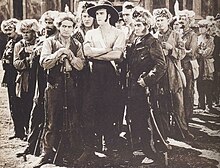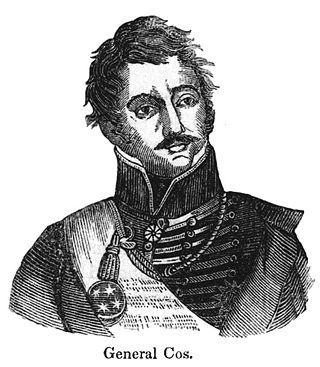
Martín Perfecto de Cos was a Mexican Army general and politician during the mid-19th century. Born in Veracruz, the son of an attorney, he became an army cadet at the age of 20, a Lieutenant in 1821, and a Brigadier General in 1833.

Samuel Alfred De Grasse was a Canadian actor. He was the uncle of cinematographer Robert De Grasse.

The Battle of the Alamo was a pivotal event and military engagement in the Texas Revolution. Following a 13-day siege, Mexican troops under President General Antonio López de Santa Anna reclaimed the Alamo Mission near San Antonio de Béxar. About one hundred Texians were then garrisoned at the mission, with around a hundred subsequent reinforcements led by eventual Alamo co-commanders James Bowie and William B. Travis. On February 23, approximately 1,500 Mexicans marched into San Antonio de Béxar as the first step in a campaign to retake Texas. In the early morning hours of March 6, the Mexican Army advanced on the Alamo. After repelling two attacks, the Texians were unable to fend off a third attack. As Mexican soldiers scaled the walls, most of the Texian fighters withdrew into interior buildings. Those who were unable to reach these points were slain by the Mexican cavalry as they attempted to escape. Between five and seven Texians may have surrendered; if so, they were quickly executed. Subsequently almost all of the Texian inhabitants were killed.

Erastus "Deaf" Smith, who earned his nickname due to hearing loss in childhood, was an American frontiersman noted for his part in the Texas Revolution and the Army of the Republic of Texas. He fought in the Grass Fight and the Battle of San Jacinto. After the war, Deaf Smith led a company of Texas Rangers.
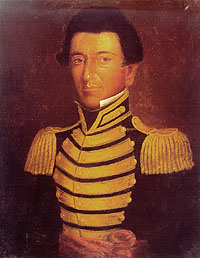
Juan Nepomuceno Seguín was a Spanish-Tejano political and military figure of the Texas Revolution who helped to establish the independence of Texas. Numerous places and institutions are named in his honor, including the county seat of Seguin in Guadalupe County, the Juan N. Seguin Memorial Interchange in Houston, Juan Seguin Monument in Seguin, World War II Liberty Ship SS Juan N. Seguin, Seguin High School in Arlington.

The Alamo is a 2004 American war historical drama about the Battle of the Alamo during the Texas Revolution. The film was directed by John Lee Hancock, produced by Ron Howard, Brian Grazer, and Mark Johnson, distributed by Buena Vista Pictures, and starring Dennis Quaid as Sam Houston, Billy Bob Thornton as Davy Crockett, Jason Patric as Jim Bowie, and Patrick Wilson as William B. Travis. The screenplay is credited to Hancock, Stephen Gaghan, and Leslie Bohem.

The Alamo is a 1960 American epic historical war film about the 1836 Siege and Battle of the Alamo produced and directed by John Wayne and starring Wayne as Davy Crockett. The film also co-stars Richard Widmark as Jim Bowie and Laurence Harvey as William B. Travis, and features: Frankie Avalon, Patrick Wayne, Linda Cristal, Joan O'Brien, Chill Wills, Joseph Calleia, Ken Curtis, Ruben Padilla as Santa Anna, and Richard Boone as Sam Houston. Shot in 70 mm Todd-AO by William H. Clothier, it was released by United Artists.
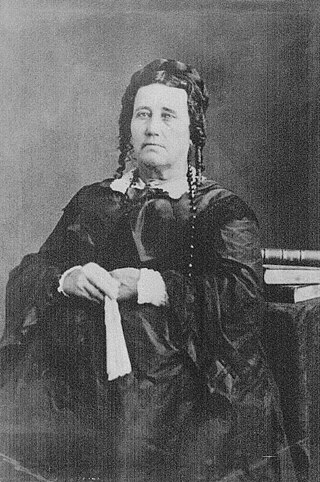
Susanna Wilkerson Dickinson and her infant daughter, Angelina, were among the few American survivors of the 1836 Battle of the Alamo during the Texas Revolution. Her husband, Almaron Dickinson, and 185 other Texian defenders were killed by the Mexican Army.
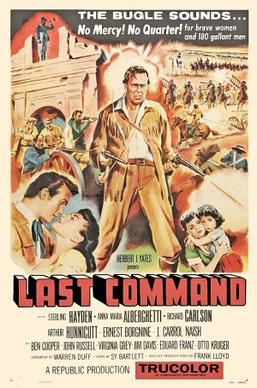
The Last Command is a 1955 American Western film directed by Frank Lloyd starring Sterling Hayden, Anna Maria Alberghetti, Richard Carlson, Arthur Hunnicutt, Ernest Borgnine and J. Carrol Naish based on the life of Jim Bowie and the Battle of the Alamo.

The Immortal 32 was a relief force of thirty-two Texian Militia from the Gonzales Ranger Company who reinforced the Texians under siege at the Alamo. They are "immortalized" as the only unit to answer the To the People of Texas & All Americans in the World letter. Along with the other Alamo defenders, they were all killed and burned after the Battle of the Alamo.

The Immortal Alamo is an American silent film released on May 25, 1911. The Immortal Alamo is the earliest film version of the events surrounding the 1836 Battle of the Alamo. The film was directed by William F. Haddock and produced by Gaston Méliès. The film's cast included Francis Ford, Edith Storey, William A. Carroll, and one hundred cadets from the Peacock Military Academy. The film was said to be 10 minutes in length and focused on the formula of "pretty girl, shy hero, and a villain" during the battle.

The siege of the Alamo was the first thirteen days of the Battle of the Alamo. On February 23, Mexican troops under General Antonio Lopez de Santa Anna entered San Antonio de Bexar, Texas, and surrounded the Alamo Mission. The Alamo was defended by a small force of Texians and Tejanos, led by William Barrett Travis and James Bowie, and included Davy Crockett. Before beginning his assault on the Alamo, Santa Anna offered them one last chance to surrender. Travis replied by opening fire on the Mexican forces and, in doing so, effectively sealed their fate. The siege ended when the Mexican Army launched an early-morning assault on March 6. Almost all of the defenders were killed, although several civilians survived.

The Battle of the Alamo left a substantial legacy and influence within American culture and is an event that is told from the perspective of the vanquished.
Salvador Flores served as a volunteer in the Texan Army in 1835–1836. He was instrumental in organizing and commanding Texian volunteers in support of the Texas Revolution. He participated in many battles and would rise through the ranks to reach Captain status during the fight for Texas independence from Mexico. Salvador continued to provide protection for the ranches and settlers of Texas throughout the Republic years.

Manuel Flores served as a volunteer in the Texas army in 1835–1838. Fighting and commanding, he rose through the ranks to reach sergeant status during the fight for Texas independence and was commissioned a captain during the Republic years.
George C. Kimble was the commander of the Immortal 32 who died at the Battle of the Alamo. Kimble County in the hill country of Texas is named in his honor.
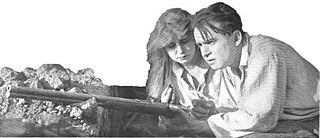
The Lamb is a 1915 American silent comedy/Western film featuring Douglas Fairbanks in his first starring role. Directed by W. Christy Cabanne, the film is based on the popular 1913 Broadway play The New Henrietta, in which Fairbanks co-starred with William H. Crane, Amelia Bingham and a very young Patricia Collinge.

The Half-Breed is a 1916 film directed by Allan Dwan. It stars Douglas Fairbanks as Lo Dorman a man competing for the love of the local preacher's daughter with the local sheriff. The audience, however, are informed that Sheriff Dunn is actually Lo's father.
William Ewart Fildew, billed as either William Fildew or William E. Fildew, was an American cinematographer during the silent film era. He shot 54 films between 1915 and 1927. His first film was 1915's The Lost House, directed by Christy Cabanne and starring Lillian Gish. That same year he also shot Martyrs of the Alamo, directed by Cabanne, which was the first film in which Douglas Fairbanks appeared. Fairbanks' first starring role, also in 1915, was The Lamb, which Fildew also shot. His final film was The Wreck, directed by William James Craft and starring Shirley Mason and Malcolm McGregor.
